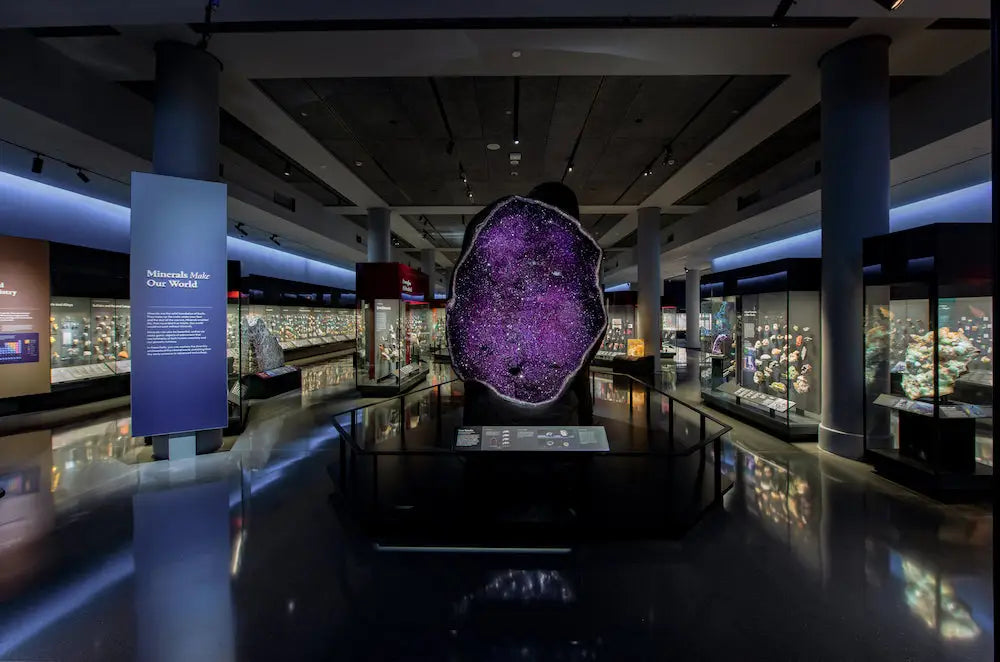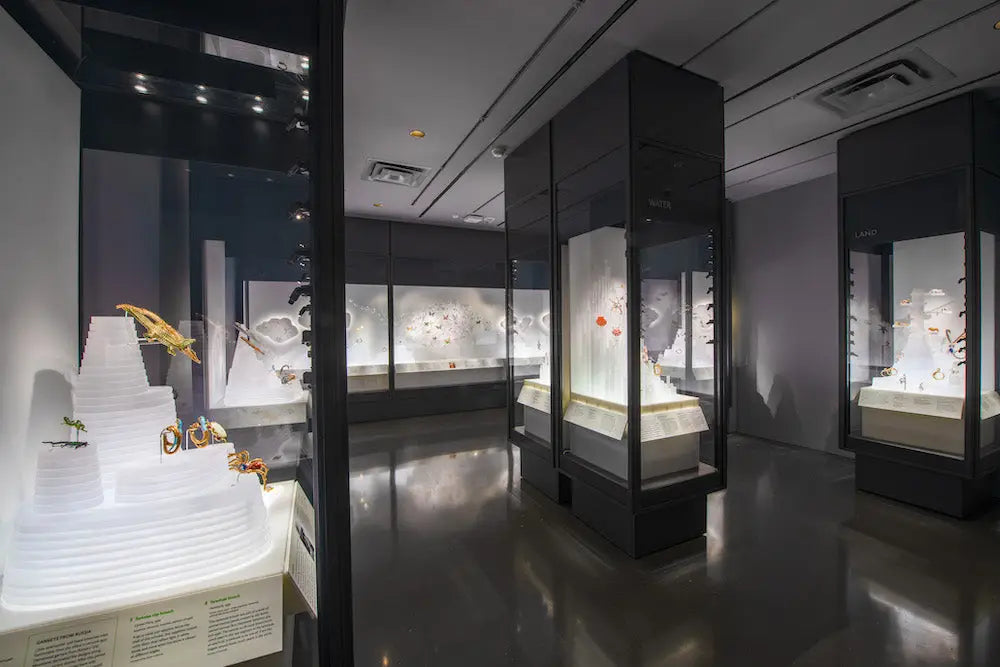
‘World’s Large Jewelry Box’ Reimagined to Mark 150 Years of AMNH
As part of its 150th anniversary celebration, the American Museum of Natural History in New York unveiled the Allison and Roberto Mignone Halls of Gems and Minerals on June 12, a completely re-envisioned and reinstalled permanent exhibit of its world-renowned collection of gems and minerals that features more than 5,000 items from 98 countries. These include the legendary Star of India sapphire, as well as magnificent new specimens never before exhibited.

The American Museum of Natural History Hall of Minerals overview.
The Mignone Halls’ reimagined exhibits tell the fascinating story of how the vast diversity of mineral types arose on Earth, how scientists classify them and how humans have used them throughout time for personal adornment, tools and technology. They also serve as a vital educational resource for students of all ages to acquire current scientific knowledge about the mineral sciences of our dynamic planet.
“New Yorkers and visitors have long embraced these Halls as one of the city’s treasures,” said Ellen V. Futter, president of the American Museum of Natural History. “Now, with this complete redesign made possible by Allison and Roberto Mignone, the Halls are more spectacular than ever and an even greater resource for learning about the processes that shape our changing planet and make it so endlessly fascinating.”

At 563 carats, the Star of India is the world's largest gem-quality blue star sapphire. Some 2 billion years old, it is considered one of the most well-known objects in the world.
The exhibit includes three main divisions: the Gem Hall, the Mineral Hall and the Melissa and Keith Meister Gallery for temporary exhibitions.
The sapphire Gem Hall includes a display of nearly 2,500 gemstones, carvings and stunning jewelry from around the world that were fashioned from natural minerals. Highlights include the spectacular 563-carat Star of India, a 2 billion-year-old gem that’s the largest gem-quality blue star sapphire known. It’s celebrated for its well-defined star, which is visible on both sides. In addition to the Star of India, there’s the Patricia Emerald, the largest gem-quality emerald reported from the Chivor Mine in Colombia. Famous for its crystal perfection, vibrant color and large 632-carat weight, the Patricia Emerald is remarkable for being one of the very few large emeralds that have been preserved uncut.

The 632-carat Patricia Emerald is a dihexagonal (12-sided) crystal and is considered one of the great emeralds of the world. Found in Colombia in 1920, it was named after the mine owner's daughter. It is one of the very few large emeralds that have been preserved uncut.
There’s also the DeLong Star Ruby, a gorgeous 100.3-carat star ruby from Myanmar; the Princess Topaz, a 221-facet, 9.5-pound pale-blue topaz that was once the largest cut gem in the world; and a beautiful carving of the Buddhist deity Guan Yin in lavender jadeite jade, fashioned in China during the late Qing Dynasty.

The DeLong Star Ruby, a 100.3-carat star ruby from Myanmar.
For diamond carat lovers, high points include the Butterfly of Peace, 240 colored natural diamonds arranged in a symmetrical pattern of similar cuts and colors, and the Organdie Necklace, an outstanding lattice-work girandole bib necklace showcasing 2,190 round and pear-shaped diamonds totaling 110 carats set in platinum, designed by Michelle Ong for Carnet.

The Mineral Hall comprises four sections: Mineral Forming Environments is dedicated to the geological conditions and processes by which minerals form: igneous, pegmatitic, metamorphic, hydrothermal and weathering. Two spectacular examples of igneous rocks are an iridescent block of labradorite from Madagascar made up of large crystals of feldspar that display vibrant colors with changes in viewing angle, as well as an ancient block of orbicular granite featuring unusual ball-shaped, radial clusters of crystals. Standout pegmatites include a massive 5-foot beryl crystal section, sourced from the Bumpus Quarry in Albany, Maine, and a nearly 600-pound specimen of topaz from Minas Gerais, Brazil, one of the largest single crystals of topaz in any museum in the world. Metamorphic specimens, meanwhile, include a slab of amphibolite rock containing huge almandine garnet crystals that formed more than a billion years ago, sourced from Gore Mountain in upstate New York, as well as a 1.8-billion-year-old assemblage of large dravite tourmaline crystals, one of the oldest pieces in the Halls, which formed in present-day Western Australia in metamorphic rock.

This slab of amphibolite rock sourced from Gore Mountain in upstate New York contains huge almandine garnet crystals that formed more than a billion years ago.
Mineral Fundamentals, at the four corners of the layout, explore the overarching concepts of mineral sciences, from the evolution and diversification of minerals to their properties, to how they have been used by humans from prehistory to present day.

This display illustrates the concept of mineral evolution, a theory which has developed over the past 15 years.
Systematic Classification, a display running along the west wall, contains 659 specimens that represent the chemical classification system that scientists use to organize Earth’s more than 5,500 mineral species, as well as a cool interactive feature in which visitors can explore forming minerals from the elements on the periodic table.

This interactive display illustrates the periodic table of chemical elements and allows visitors to "make minerals."
Finally, Minerals & Light, a room off the east wall, explores the optical properties of minerals and how fashioning them into gems can enhance those properties and make them even more visually spectacular. Visitors can learn what causes color (and how one sapphire stone can have many colors), why some minerals display “play of color” or iridescence, why we shape and cut gems—including what makes a gem sparkle—how some gems have “eyes” and “stars,” and why some minerals glow. The centerpiece here is the wall-sized slab from the Sterling Hill Mining Museum in Ogdensburg, N.J., that dramatically glows under four different lighting conditions: white light, long-wave ultraviolet, short-wave ultraviolet and darkness.

The centerpiece of the Minerals & Light room is a wall-sized panel of fluorescent rock that glows in shades of orange and green, sourced from Sterling Hill in New Jersey.
The Halls are named in honor of Allison and Roberto Mignone, longtime Museum supporters and volunteers.
“When you enter the Halls, you truly feel as if you’ve walked into the world’s jewelry box,” said Allison Mignone. “These Halls, and others in the Museum, take science off the page of textbooks and into the real-life experience of countless families and students. Now more than ever, equal access to education is paramount. We look forward to the time when large numbers of students and school groups and their teachers can visit. Halls like these are crucial and tangible tools that communicate the incredible variety of minerals on Earth and how they relate to our lives.”
Reservations to visit the Allison and Roberto Mignone Halls of Gems and Minerals are included in a General Admission ticket and are available now at ticketing.amnh.org.
About the American Museum of Natural History
The American Museum of Natural History, founded in 1869, is one of the world’s preeminent scientific, educational and cultural institutions. The Museum encompasses more than 40 permanent exhibition halls, including those in the Rose Center for Earth and Space and the Hayden Planetarium, as well as galleries for temporary exhibitions. The Museum’s scientists draw on a world-class permanent collection of more than 34 million specimens and artifacts, some of which are billions of years old, and on one of the largest natural history libraries in the world. Visit amnh.org for more information.


